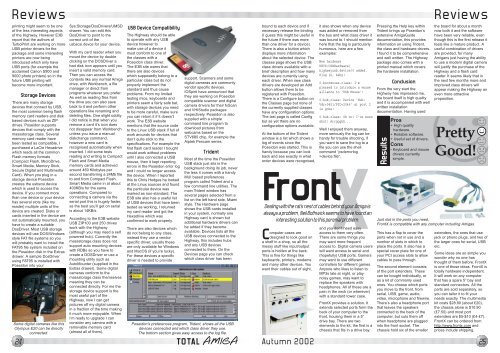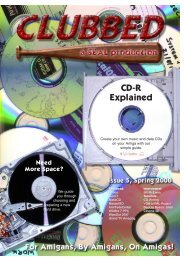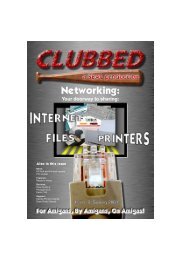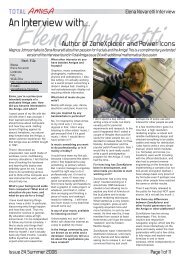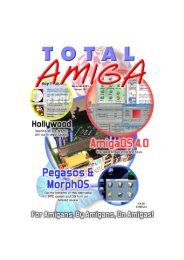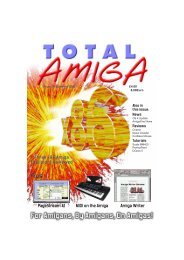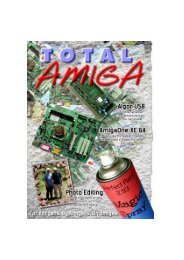Download issue 12 - Total Amiga Magazine
Download issue 12 - Total Amiga Magazine
Download issue 12 - Total Amiga Magazine
- TAGS
- download
- amiga
- totalamiga.org
You also want an ePaper? Increase the reach of your titles
YUMPU automatically turns print PDFs into web optimized ePapers that Google loves.
Reviews<br />
printing might seem to be one<br />
of the less interesting aspects<br />
of the Highway. However E3B<br />
report that the authors of<br />
TurboPrint are working on more<br />
USB printer drivers for the<br />
package and some interesting<br />
printers are now being<br />
introduced which only have<br />
USB ports (for example the<br />
acclaimed Canon S900 and<br />
9000 photo printers) so in the<br />
future USB printing will<br />
become more important.<br />
Storage Devices<br />
There are many storage<br />
devices that connect by USB,<br />
the most common being flash<br />
memory card readers and disk<br />
based devices such as ZIP<br />
drives. Poseidon supports<br />
devices that comply with the<br />
massstorage class. Several<br />
memory card reader have<br />
been tested as compatible, I<br />
purchased a LaCie Hexadrive<br />
which reads all the common<br />
Flash memory formats<br />
(Compact Flash, MicroDrive,<br />
Smart Media, Memory Stick,<br />
Secure Digital and Multimedia<br />
Card). When you plug in a<br />
storage device Poseidon<br />
creates the usbscsi.device<br />
which is used to access the<br />
device. If you connect more<br />
than one device or your device<br />
has several slots (like my<br />
reader) multiple units of the<br />
device are created. Disks or<br />
cards inserted in the device are<br />
not automatically mounted, you<br />
have to create a suitable<br />
DosDriver. Most USB storage<br />
devices will use DOS/Windows<br />
style FAT file systems so you<br />
will probably want to install the<br />
FAT95 file system included on<br />
the Poseidon disk in the Extras<br />
drawer. A sample DosDriver<br />
using FAT95 is installed with<br />
Poseidon into your<br />
Some digital cameras like this<br />
Olympus E20 can be directly<br />
connected.<br />
Sys:Storage/DosDrivers/UMSD<br />
drawer. You can edit this<br />
DosDriver to point to the<br />
correct unit of the<br />
usbscsi.devce for your device.<br />
With my card reader when you<br />
mount the device by double<br />
clicking on the DOSDriver a<br />
bad disk icon appears until you<br />
insert a valid memory card.<br />
Then you can access the<br />
contents like any normal <strong>Amiga</strong><br />
drive, with Workbench, a file<br />
manager or direct from<br />
programs whatever you prefer.<br />
As well as reading files from<br />
the drive you can also save<br />
back to it and perform other<br />
operations like renaming and<br />
deleting files. One slight oddity<br />
I did notice is that when you<br />
remove a card it’s icon does<br />
not disappear from Workbench<br />
unless you <strong>issue</strong> a manual<br />
diskchange command,<br />
however a new card is<br />
recognised automatically when<br />
inserted. I did some tests<br />
reading and writing to Compact<br />
Flash and Smart Media<br />
memory cards and achieved<br />
around 460 Kilobytes per<br />
second transferring a 24Mb file<br />
to and from Compact Flash.<br />
Smart Media came in at about<br />
400KB/s for the same<br />
operations. Compared to<br />
connecting a camera via the<br />
serial port this is hugely faster,<br />
as the best you’ll get on serial<br />
is about 14KB/s.<br />
According to the E3B website<br />
USB ZIP100 and 250 drives<br />
work with the Highway<br />
(although you may need a self<br />
powered hub). Currently the<br />
massstorage.class does not<br />
support auto mounting devices<br />
with RDBs so you have to<br />
create a DOSDriver or use a<br />
mounting utility such as<br />
AutoMounter (supplied in the<br />
Extras drawer). Some digital<br />
cameras conform to the<br />
massstorage class themselves<br />
meaning they can be<br />
connected directly. For me the<br />
storage device support is the<br />
most useful part of the<br />
Highway, now I can get<br />
pictures off my digital camera<br />
in a fraction of the time making<br />
it much more enjoyable. When<br />
I’m ready to upgrade I can<br />
consider any camera with a<br />
removable memory card<br />
(almost all of them).<br />
USB Device Compatibility<br />
The Highway should be able<br />
to operate with any USB<br />
device however to<br />
make use of a device it<br />
must conform to one of<br />
the classes with a<br />
Poseidon class driver.<br />
The E3B site warns that<br />
there are also devices<br />
which supposedly belong to a<br />
particular class but do not<br />
properly implement the<br />
standard and thus cause<br />
problems. From my limited<br />
testing mice, keyboards and<br />
printers seem a fairly safe bet,<br />
with storage devices you need<br />
to be more careful, make sure<br />
you can return it if it doesn’t<br />
work. The E3B website<br />
mentions that the source code<br />
to the Linux USB stack if full of<br />
work arounds for devices that<br />
don’t quite stick to the<br />
specifications. For example the<br />
first flash card reader I bought<br />
would work without problems<br />
until I also connected a USB<br />
mouse, then it kept reporting<br />
errors in the Poseidon error log<br />
and I could no longer access<br />
the device. When I reported<br />
this to Chris Hodges he looked<br />
at the Linux sources and found<br />
the particular device was<br />
marked as non-standard. The<br />
E3B site also has a useful list<br />
of USB devices that have been<br />
tested as working, I returned<br />
my card reader and got the<br />
Hexadrive which was<br />
confirmed to work properly.<br />
There are also devices which<br />
do not belong to any class,<br />
instead they use a vendor<br />
specific driver, usually these<br />
are only available for Windows<br />
and MacOS (if you’re lucky).<br />
For these devices a specific<br />
driver is needed to provide<br />
support. Scanners and some<br />
digital cameras are commonly<br />
vendor specific devices.<br />
IOSpirit have announced that<br />
they are working on Poseidon<br />
compatible scanner and digital<br />
camera drivers for their fxScan<br />
and VHIStudio packages<br />
respectively. Poseidon is also<br />
supplied with a simple<br />
command line program to<br />
download pictures from<br />
webcams based on the<br />
STV680 chip, for example the<br />
Aiptek Pencam series.<br />
Trident<br />
Most of the time the Poseidon<br />
USB stack just sits in the<br />
background doing its job, never<br />
the less it comes with a handy<br />
MUI based preferences<br />
program called Trident and a<br />
few command line utilities. The<br />
main Trident window has<br />
several pages selected from a<br />
list on the left hand side, Miami<br />
style. The Hardware page<br />
shows the USB cards installed<br />
in your system, normally one<br />
Highway card is shown but<br />
additional hardware drivers can<br />
be added if they become<br />
available. Devices lists all the<br />
USB devices connected to the<br />
Highway, this includes hubs<br />
and any USB devices<br />
connected to them. On the<br />
Devices page you can check<br />
which class driver has been<br />
Poseidon’s preferences program, Trident, shows all the USB<br />
devices connected and which class driver they use.<br />
The bottom section gives easy access to the log file.<br />
bound to each device and if<br />
necessary release the binding<br />
(I guess this might be useful in<br />
the future if there was more<br />
than one driver for a device).<br />
There is also a button which<br />
displays more information<br />
about the selected device. The<br />
classes page shows the USB<br />
class drivers available with a<br />
brief description and how many<br />
devices are currently using<br />
each driver. When new class<br />
drivers are developed an Add<br />
button allows them to be<br />
registered with Poseidon.<br />
There is a Configure button on<br />
the Classes page but none of<br />
the currently supplied classes<br />
have any configuration options.<br />
The last page is called Config<br />
but as yet there are no<br />
configuration options available.<br />
At the bottom of the Trident<br />
window is a list which shows a<br />
log of events since the<br />
Poseidon was started. This is<br />
handy because you can look<br />
back and see exactly in what<br />
order devices were recognised,<br />
Front<br />
Computer cases are<br />
designed to look good on<br />
a shelf in a shop, so all the<br />
messy stuff like input/output<br />
ports is hidden at the back.<br />
This is fine for things like<br />
keyboards, printers, modems<br />
and many other devices. You<br />
want their cables out of sight,<br />
24 TOTAL AMIGA Autumn 2002<br />
it also shows when any device<br />
was added or removed from<br />
the bus and what class driver it<br />
was bound to. I should mention<br />
here that the log is particularly<br />
humorous, here are a few<br />
examples:<br />
New hardware<br />
DEVS:USBHardware/<br />
highwayusb.device/0 added.<br />
Plug in, baby!<br />
0-bootmouse.class: I’m<br />
pleased to introduce a mouse<br />
alliance to ‘USB Mouse’!<br />
0-hub.class: Device ‘Hub:<br />
Vdr=0451/PID=2046’ at port 2<br />
is gone!<br />
0-hub.class: Oh no! I’ve been<br />
shot! Arrggghh...<br />
Well I enjoyed them anyway,<br />
more seriously the log can be<br />
handy for trouble shooting, if<br />
you want to save the log to a<br />
file you can use the shell<br />
command “psderrorlog<br />
>device:file”.<br />
X<br />
Dealing with the rat’s nest of cables behind your <strong>Amiga</strong> is<br />
always a problem , Neil Bothwick seems to have found an<br />
interesting solution to this perenial problem.<br />
and you don’t need easy<br />
access to them very often.<br />
There are some things you<br />
may want more frequent<br />
access to. Digital camera users<br />
will want access to serial and<br />
(hopefully) USB ports. Gamers<br />
may want to use different<br />
controllers for different games.<br />
Anyone who likes to listen to<br />
MP3s late at night, or play<br />
noisy games, may want to<br />
replace the speakers with<br />
headphones. All of these are a<br />
pain in the neck (or wherever)<br />
with a standard tower case.<br />
FrontX provides a solution. It<br />
extends selected ports form the<br />
back of your computer to the<br />
front, housing them in a 5”<br />
drive bay. There are two<br />
elements to the kit, the first is a<br />
chassis that fits in a drive bay.<br />
Pressing the Help key within<br />
Trident brings up Poseidon’s<br />
extensive <strong>Amiga</strong>Guide<br />
documentation, this provides<br />
information on using Trident,<br />
the class and hardware drivers.<br />
I found it to be comprehensive<br />
and well written. The Highway<br />
package also comes with a<br />
printed manual which covers<br />
the hardware installation.<br />
Conclusion<br />
From the very start the<br />
Highway has impressed me,<br />
the board itself is high quality<br />
and it is accompanied with well<br />
written installation<br />
documentation. Having used<br />
Results<br />
Pros<br />
+ High quality<br />
hardware.<br />
+ Reliable software.<br />
+ Useful set of drivers.<br />
Cons<br />
- Keyboard and mouse<br />
drivers currently<br />
simple.<br />
This has a flap to cover the<br />
ports when not in use and a<br />
number of slots in which to<br />
place the ports. It also has a<br />
special cover plate for one of<br />
your PCI access slots to allow<br />
cables to pass through.<br />
The second element consists<br />
of the port extenders. These<br />
can be bought individually, or<br />
as a kit of commonly used<br />
ones. You choose which ports<br />
you move to the front, from<br />
serial, USB, game, audio,<br />
video, microphone and firewire.<br />
There’s also a headphone port<br />
that leaves the speakers<br />
connected to the back of the<br />
computer, but cuts them off<br />
when headphone are plugged<br />
into the front socket. The<br />
chassis hold six of the smaller<br />
Reviews<br />
the board for about a month<br />
now both it and the software<br />
have been very reliable, even<br />
though this is the first release it<br />
feels like a mature product. A<br />
useful combination of drivers<br />
are provided, for many<br />
<strong>Amiga</strong>ns just having the ability<br />
to use a modern digital camera<br />
will justify the purchase of the<br />
Highway and a flash card<br />
reader. It seems likely that in<br />
the next few months more and<br />
improved class drivers will<br />
appear making the Highway an<br />
even more attractive<br />
proposition.<br />
Pretty<br />
Good!<br />
Just slot in the ports you need,<br />
FrontX is compatible with any computer including <strong>Amiga</strong>s.<br />
extenders, the ones that use<br />
jack or phono plugs, and two of<br />
the larger ones for serial, USB<br />
etc.<br />
Some ideas are so simple you<br />
wonder why no one has<br />
thought of them before. FrontX<br />
is one of those ideas. FrontX is<br />
totally hardware independent.<br />
It will work on any computer<br />
that has a spare 5” bay and<br />
standard connectors. All the<br />
parts are sold separately, so<br />
you can tailor it to fit your<br />
needs exactly. The multimedia<br />
kit costs $28.90 (about £20),<br />
the chassis alone is $10.90<br />
(£7.50) and most port<br />
extenders are $5-$10 (£4-£7).<br />
FrontX can be ordered from<br />
http://www.frontx.com and<br />
prices include shipping.<br />
25


